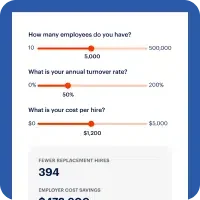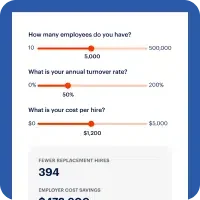We’ve read so much about the future of work and AI. The prevailing thought is AI will replace humans in many aspects of our workforce. And some worry about the loss of human interaction and connection that we thrive on. But recent research shows that’s not necessarily the case, in particular with jobs that play a vital role in our communities’ success and vibrancy.
The World Economic Forum’s in-depth Future of Jobs Report 2025, finds that many frontline roles are predicted to see some of the largest growth in volume globally over the next five years. The extensive report surveys more than 1,000 employers, who represent at least 14 million workers in 22 industry clusters and 55 economies. Many of the occupations pegged for high growth are vital to the very fabric of our communities including nurses, teachers, and retail workers.
The expected growth of these frontline occupations poses a challenge to employers mentioned in the report. In particular, U.S. nurses, teachers, and retail workers have experienced significant turnover, especially those in the early stages of their careers. A common reason why they are quitting relates to “stress,” in particular financial stress. The unpredictable economy and stubbornly high inflation are driving many to either leave their profession or find supplemental work in the gig economy.
But if frontline roles expand as predicted, employers will need to stem the tide of employee churn. So how can these employers set themselves up for success in the future and turn the high turnover tide?
Identify economic challenges
The first step is to identify the economic challenges facing these workers.
During the pandemic, no group exemplified dedication and selflessness to their communities more than nurses. But nurses have paid a price. Job-related stress and burnout are having profoundly negative impacts on nurses. Research shows that 33 percent of all new nursing hires leave within a year; 53 percent of those leaving have two or fewer years experience. The highest turnover levels, 75 percent, are nurses with five or fewer years of experience.
In addition, 68 percent of healthcare workers in the U.S., including nurses, feel stressed about their financial state, per a study commissioned by DailyPay. In addition, the study found that 49 percent find it challenging to pay bills on time and 34 percent say they ran out of money between paychecks in the past year.
It’s not just healthcare
Similarly, teachers are feeling the brunt of job-related stress and burnout. Research shows that more than 75 percent of teachers have reported having stress-related health issues. And school districts are seeing the negative impact. For example, in the U.S., 86 percent of public schools are challenged in hiring educators while 35 percent of teachers are “fairly likely” to leave teaching in the next two years. The majority, 61 percent of U.S. teachers, also experience financial stress; many are choosing to get second jobs or are thinking of finding a better paying one. The DailyPay poll also shows that 42 percent report challenges paying bills on time; 27 percent of teachers reported running out of money between paychecks in 2024.
The retail industry is also dealing with significant employee turnover. And those employees are not just leaving their respective companies, they are leaving the industry altogether. A McKinsey report noted that 72 percent of retail employees who quit their jobs in the past three years left the industry completely. Retail employees often cite fluctuating hours, which can disrupt work-life balance, as one reason.
Their other challenge, as with nurses and teachers, is being able to make ends meet. According to a PwC survey, 39 percent of retail employees reported often or always running out of money between paychecks, indicating a large number of them face financial stress with the rising costs of living.
The onus is on employers
With economic challenges so prevalent in all three sectors, the onus is on employers to provide the right tools and benefits that not only help them navigate these challenging economic waters, but make them feel valued and appreciated.
A recent BrightPlan survey revealed that 95 percent of employees believe that having employer-provided tools and education would positively impact them. The survey also found that 60 percent shared they would work harder, while 59 percent would feel more financially secure. Also, 58 percent said their productivity and engagement levels would rise, and 34 percent shared they would be more loyal and committed to their employer. In fact, more than 90 percent of employees link overall job satisfaction with their benefits package, according to a QuickBooks-Allstate Health Solutions survey.
Keep in mind, it’s not just about deploying a typical benefits package that checks the boxes for staples such as 401(k) or retirement planning. It’s about benefits that make a true impact on their day-to-day life. A benefit that can be leveraged to help employees make the most of every day. Today, the majority of American workers are living paycheck to paycheck. And those numbers will only increase with a fluctuating economy. Simply raising wages is not enough.
Review your benefits
The timing of employees’ pay and bills often don’t align, so solutions addressing the hours worked compared to their daily budget are critically needed. On-Demand Pay is a financial wellness benefit which is the second most adopted benefit by our employer clients. Behind health benefits, it is a solution that provides workers with financial flexibility to make ends meet. It also offers much-needed visibility and transparency at the press of a phone button, into their spending power in real time. This insight is why it’s often the first app they check in the morning and the last thing they check after a day’s work.
Benefits with this type of impact are not only good for the employees, but good for everyone involved. According to Society for Human Resource Management research, replacing an employee usually costs six to 24 months of their salary in recruitment, onboarding, and training expenses. But when communities lose teachers or nurses, the impact goes far beyond financial costs. It can be truly devastating. That’s why employers must ensure tomorrow’s frontline heroes have everything they need not just to survive in these essential roles, but to truly thrive in them.

















